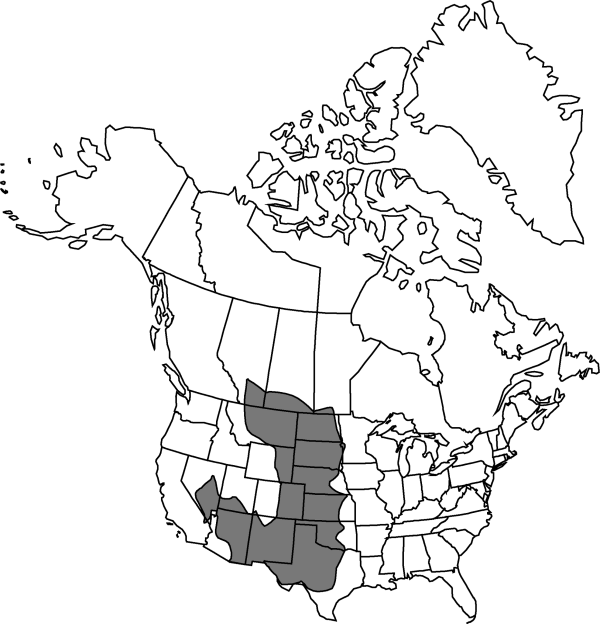Coryphantha vivipara
in N. L. Britton and A. Brown, Ill. Fl. N. U.S., ed. 2, 2: 571. 1913.
Plants usually unbranched or with age in some populations to 30 branches, most branches of largest clumps often immature, stems usually stiff and erect, smooth in immature plants to sparsely and coarsely needle-covered in adult plants. Roots ± diffuse, less than 1/4 of stem diam. Stems usually more than 1/2 above ground (sometimes deep-seated and flat-topped in winter, in cold climates and/or in immaturity), oblate, spheric, ovoid, obovoid, or cylindric with age, 2.5–20 × 3–11 cm; tubercles 8–25 × 3–8 mm, stiff or ± flaccid; areolar glands absent; parenchyma not mucilaginous (except possibly in far north); druses in pith and cortex present, some large, 0.7–1 mm diam., lenticular, usually conspicuous in old parts of stem; pith 1/5–2/3 of lesser stem diam.; medullary vascular system present. Spines 11–55 per areole; radial spines 10–40 per areole, weakly appressed or tightly appressed, pectinately arranged in subadults of some populations, either bright white, ashy white, pale tan, pale pinkish gray, or reddish brown (rarely stramineous), tips dark bright pinkish brown, reddish brown, dark brown, orange-brown, or pinkish orange on all or only largest spines (dark tips rarely absent), 7–22 × 0.08–0.6 mm; subcentral spines sometimes present in adaxial parts of clusters; central spines straight, snowy white, ashy white, reddish brown, sepia, purplish gray, pinkish gray, brownish red, pinkish brown, horn colored, pale tan, dark purplish brown, or stramineous, opaque or vitreous, fading, then blackening with age; outer central spines 3–14 per areole; inner central spines (0–)1(–4) per areole, appressed or strongly projecting, in “bird’s-foot” arrangement or radiating like spokes, longest spines 9–25 × 0.2–0.7 mm. Flowers slightly subapical, 20–57 × 25–67(–90?) mm; outer tepals conspicuously fringed; inner tepals 21–56 per flower, usually spreading, recurved, pale rose-pink to reddish pink or magenta, sometimes with darker midstripes, sometimes shading to white or pale greenish, proximally magenta, often darkest distally, 15–35 × 1.3–6 mm; outer filaments magenta or basally white (rarely entirely white or greenish white), seldom contrasting with inner tepals and, if so, then paler; anthers bright dark yellow (rarely orange-yellow); stigma lobes 5–13, erect or ascending, white to magenta, 2.5–5.5 mm. Fruits green, exposed portions slowly turning dull brownish red, ovoid to obovoid, 12–28 × 7–20 mm, juicy; floral remnant persistent. Seeds bright reddish brown, comma-shaped or nearly obovoid, (1–)1.3–2.4(–3) mm, pitted. 2n = 22.
Phenology: Flowering spring–late summer (Apr–Aug); fruiting 2-5 months after flowering.
Habitat: Desert scrub to conifer forest, mostly low hills or mountaintops, diverse substrates
Elevation: 200-2700 m
Distribution

Alta., Man., Sask., Ariz., Calif., Colo., Kans., Minn., Mont., Nebr., Nev., N.Mex., N.Dak., Okla., S.Dak., Tex., Utah, Wyo., Mexico (Chihuahua, Coahuila, Sonora).
Discussion
Coryphantha vivipara is the most widespread, abundant and variable member of the genus, but it is rare in Mexico. Reports of it from Oregon, Idaho, and northern Utah are incorrect (A. D. Zimmerman 1985).
In the northwestern part of its range, Coryphantha vivipara may occur with Pediocactus simpsonii, which differs in seed color and texture, fruit dehiscence and succulence, and location of flowers/fruits on the plant; sterile material may be distinguished by spine and bract characteristics.
Coryphantha vivipara flowers are virtually identical to those of C. macromeris and Mammillaria wrightii; in the absence of vegetative material, flowers may be unidentifiable. Some unrelated species, such as C. echinus, vegetatively resemble C. vivipara, but those particular species usually have (1) some of the central spines slightly curved, (2) a few areolar glands present, or (3) no medullary vascular system. The large lenticular druses (to 1 mm wide) in the pith and cortex of C. vivipara are shared only with C. sneedii.
Selected References
None.